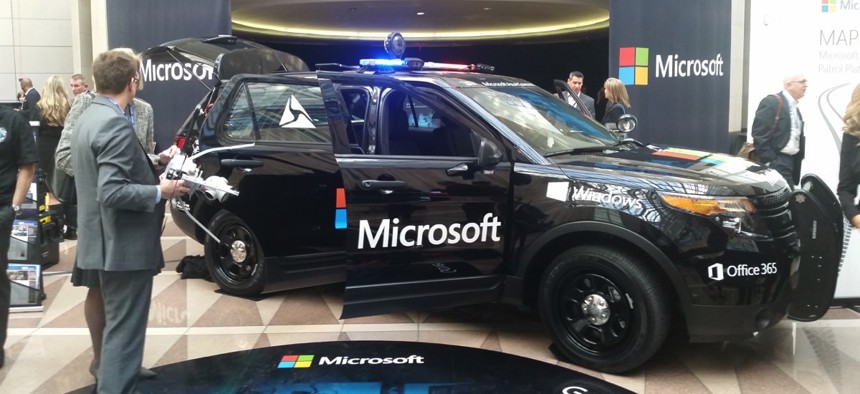Local Police Embrace the Internet of Things

A Ford Police Interceptor outfitted with the Microsoft Advanced Patrol Platform. Dave Nyczepir / Route Fifty
From body cameras to drones, Microsoft is helping law enforcement agencies connect the latest tech through the cloud.
WASHINGTON — The Microsoft Advanced Patrol Platform is making the Internet of Things reality in day-to-day policing scenarios by connecting data-gathering law enforcement devices and sensors through the Azure cloud.
On display at Tuesday’s Microsoft Government Cloud Forum in the nation's capital was the police car of the future—the Redmond, Washington-based technology giant’s take on the Ford Police Interceptor—capable of collecting information in real-time when outfitted with subsonic and supersonic gunshot sensors, cameras or license plate recognition tech.
That data can have analytics applied to it for better decisionmaking by police and government officials or be viewed in the field when, say, a robot is sent into a hostage situation.
“The S.W.A.T. leader, when he gets that page, can log on and instantly see what they’re dealing with,” said Shannon Leahy, Microsoft Global Security & Technology security program manager, during a panel discussion. “They can get all that information right there from their tablet.”
Microsoft has been working with its law enforcement and tech partners to make the Interceptor, which operates as more of a command center at the scene, customizable with tools like NC4 Street Smart.
The data collection and situational awareness platform for patrol officers speeds up the processing of information from the frontline. Throughout the U.S., 35 police agencies use the software, including Bloomington, Indiana, which deployed Street Smart in two weeks—solving 10 burglaries, making three arrests and recovering several stolen vehicles during that time.
Genetec AutoVu license plate-reading (LPR) tech can be outfitted in four directions on a squad car’s exterior, so officers don’t have to worry about trying to remember the make and model of every vehicle they stop during their ship. Plates are captured as the car moves along, and fixed-base LPR installations can also be placed at city entrances, airports and major events like sporting games or concerts.
This summer, St. Louis deployed 140 general surveillance cameras to gain a full operational view of the city—directly attributable to 46 arrests made thanks to LPR tech. Del Rio, Texas, an early adopter, went from running 20 plates a shift to several thousand with AutoVu, and the tech is especially handy during amber alerts for missing children.
“It’s certainly a huge enabling technology for them that’s brought a lot of value,” said Justin Himelberger, Genetec regional sales manager. “To get the most out of the system, you really need to start sharing that information across multiple systems.”
That's where the Azure cloud comes in. When code enforcement personnel scan the plate of a car with a parking violation, they can instantly see if there's a stolen car alert on the vehicle.
Another Microsoft partner, Taser, has invested heavily in police body cameras, as well as dash and fixed-site cams talking to its cloud-based platform evidence.com for the management, tagging, searching and editing of video in cities like Washington, D.C., and Houston.
The fourth partner on Tuesday’s IoT panel was Aeryon with its SkyRanger unmanned aerial system. Equipping squad cars with drones might not be feasible for smaller police agencies, but the SkyRanger fits in the trunk and provides an airborne vantage point from which to gather data.
SkyRanger allows for 2D and 3D modeling of traffic collisions by flying a lateral pattern across incident sites, controlled with an easy-to-use, ruggedized tablet.
“That’s reducing the time a road is closed by as much as 80 percent,” said David Prouix, Aeryon product and marketing vice president. “You don’t need to be a highly skilled pilot to fly it.”
Dave Nyczepir is a News Editor for Government Executive’s Route Fifty.
NEXT STORY: Google Stuck Waiting in Line at the DMV; Seeking State Troopers in Washington






